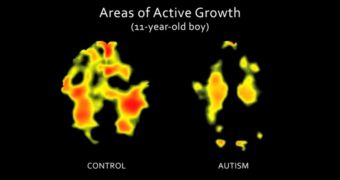University of California in Los Angeles (UCLA) investigators say that the brains of autistic children do not develop as fast and as efficiently as the brains of healthy kids of comparable age and status. This discovery potentially indicates new avenues of research when it comes to understanding autism, and developing a way of addressing it. This study was carried out on 11-year-old children. This age was determined to be critical for brain capabilities.
Researchers were also able to demonstrate that the areas of the brain which are needed for language and social skill are not connected in the brains of autistic children until much later. In normal children, these regions are connected to each other very early on.
Details of the new research study appear in the latest online issue of the esteemed journal Human Brain Mapping. The senior author of the study was UCLA Semel Institute for Neuroscience and Human Behavior professor of psychiatry Jennifer G. Levitt.
Xue Hua, a postdoctoral researcher at the university, was the first author of the work. Together with their colleagues, the two investigators used advanced brain-imaging techniques to compare the neural development patterns of autistic and non-autistic kids.
The study revealed that areas of the brain implicated in controlling social impairment, communication deficits and repetitive behaviors in autism displayed aberrant growth rates. These development patterns looked nothing like the normal ones seen in healthy children.
“Because the brain of a child with autism develops more slowly during this critical period of life, these children may have an especially difficult time struggling to establish personal identity, develop social interactions and refine emotional skills,” Hua explains.
“This new knowledge may help to explain some of the symptoms of autism and could improve future treatment options,” the investigator goes on to say. At this point, official statistics indicate that as many as one in 110 kids in the United States suffers from autism.
“The brain regions where growth rates were found to be the most altered were associated with the problems autistic children most often struggle with – social impairment, communication deficits and repetitive behavior,” Hua concludes.
Funds for the new research were provided by the US National Institutes of Health, the National Alliance for Autism Research, the National Institute of Mental Health and the National Institute of Neurological Disorders and Stroke.

 14 DAY TRIAL //
14 DAY TRIAL //